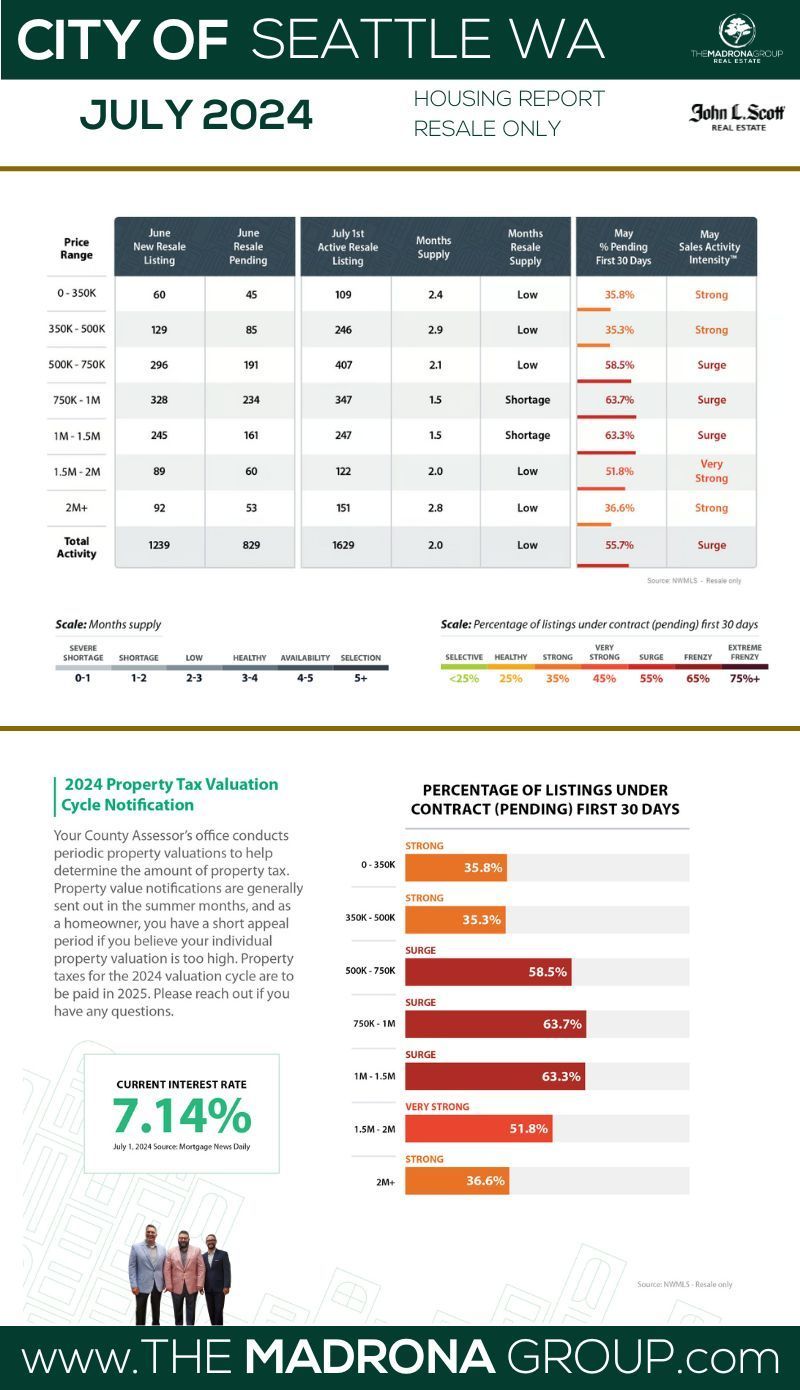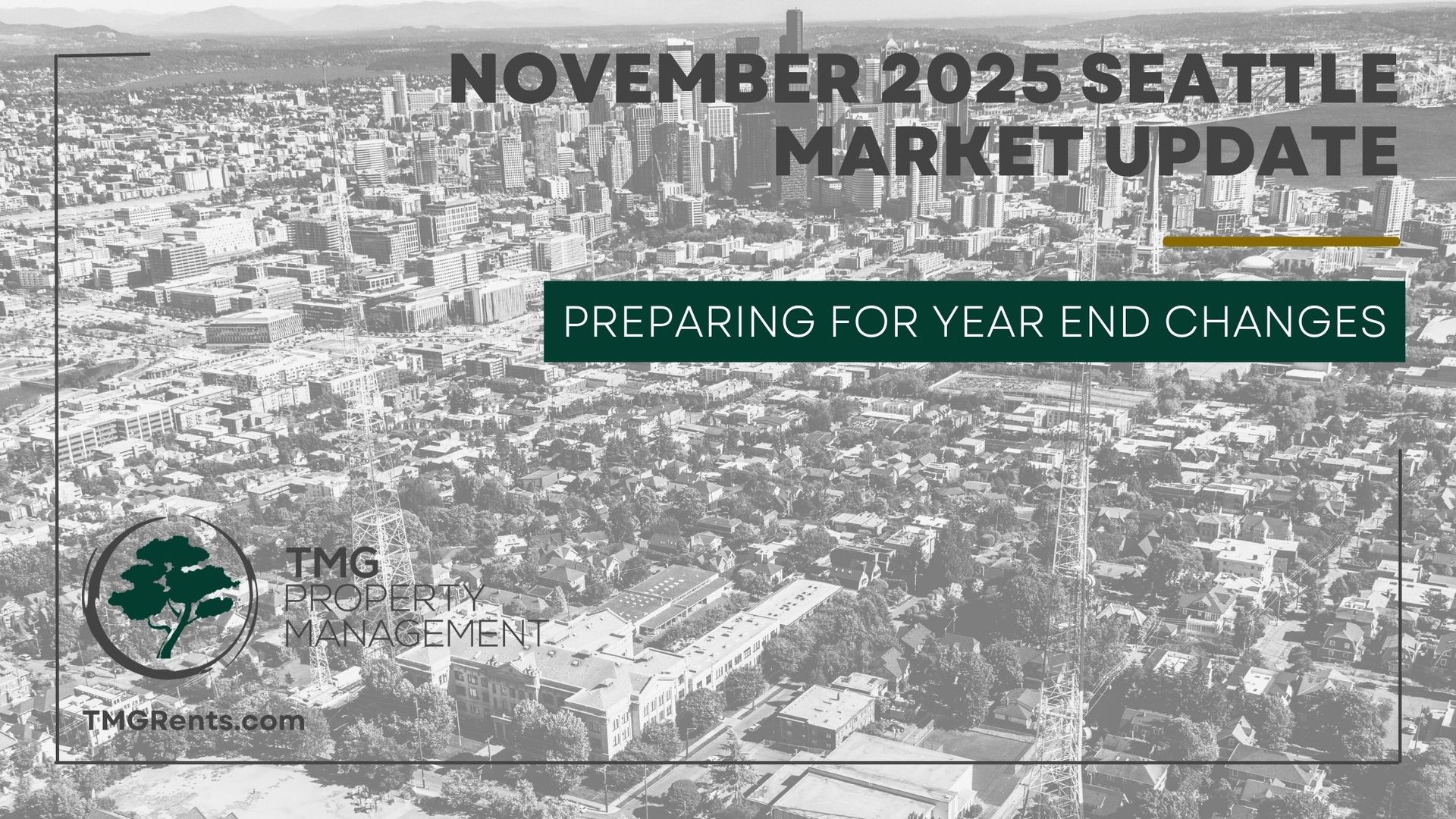July 2024 Seattle Real Estate Market Update
THE SEATTLE HOUSING MARKET AT A GLANCE

3 KEY INDICATORS OF SEATTLE HOUSING MARKET
1.SALES ACTIVITY INTENSITY:
- 55.7% (SURGE)
2. INTEREST RATE:
- 7.14% (UNCOMFORTABLE)
3. INVENTORY LEVEL:
- 2 Months (LOW)
THE BIG DEAL
Inventory levels are starting to creep back up for the summer market. This increase in available homes is offering more options for buyers, even as interest rates continue to remain a point of concern. We're seeing a shift from the typically intense spring market, providing a bit of breathing room for those looking to purchase a home in Seattle
FOR THE COMPLETE REPORT GO TO: https://www.themadronagroup.com/seattle-housing-market-report/
Seattle Housing Market JULY 2024: Low Inventory, Surging Sales, and Uncomfortable Rates
Hey there! Welcome to the Seattle housing market update for July 2024. Things are heating up this summer, and we're seeing some pretty interesting trends. With inventory levels sitting low at just 2 months, a sales intensity of 55.7% that's downright surging, and interest rates at an uncomfortable 7.14%, there's a lot to unpack.
Seattle's got that unbeatable combo of a booming tech scene and a vibrant cultural vibe, making it a magnet for homebuyers and investors. This month, we're diving into three key areas: Sales Activity Intensity, Monthly Inventory Levels, and Interest Rates. By breaking these down, we hope to give you a clear picture of what's going on in the market right now, so you can make smart moves whether you're buying, selling, or just keeping an eye on things.
Detailed Explanation of the 3 Key Indicators
- Sales Activity Intensity:
- Definition: This metric reflects the percentage of homes that go under contract within the first 30 days of listing. It's a direct indicator of the market's temperature, showing how quickly homes are moving from listing to pending status.
- Scale:
- <25%: Buyer's market – low demand, homes take longer to sell.
- 25%: Healthy market – balanced demand and supply.
- 35%: Strong market – increasing demand, sellers have a slight advantage.
- 45%: Very strong market – high demand, multiple offers are common.
- 55%: Surge – very high demand, significantly more buyers than available homes.
- 65%: Frenzy – extreme demand, homes sell extremely quickly, often well above asking price.
- 75%+: Extreme frenzy – unprecedented demand, highly competitive conditions.
- Monthly Inventory Levels:
- Definition: This measures the number of months it would take to sell all current listings at the current sales pace without any new listings being added. It's a critical indicator of market balance.
- Scale:
- 0-1 month: Severe shortage – extremely low inventory, seller's market.
- 1-2 months: Shortage – low inventory, strong seller's advantage.
- 2-3 months: Low – less inventory, leaning towards sellers.
- 3-4 months: Healthy – balanced between buyers and sellers.
- 4-5 months: Selectability – more options for buyers, slight buyer's advantage.
- 5+ months: Buyer's market – high inventory, buyers have leverage.
- Interest Rates:
- Definition: This refers to the average mortgage rate available to homebuyers. Interest rates are a significant factor affecting affordability and buyer demand.
- Scale (not a fixed scale but commonly accepted ranges):
- 3-4%: Excellent – very favorable for buyers.
- 5-6%: Good – relatively affordable for most buyers.
- 7-8%: Uncomfortable – can slow down buyer activity as financing becomes more expensive.
- 9-10%: Challenging – high rates can lead to decreased demand and slower market activity.
Each of these indicators plays a crucial role in interpreting the dynamics of the Seattle housing market. By analyzing trends within these metrics, we can better understand the forces at play, predict future movements, and strategize accordingly. Whether you're looking to buy a home, sell one, or simply keep an eye on market developments, these indicators provide the insights needed to navigate the complexities of Seattle's real estate landscape.
The Seattle housing market continues to be a whirlwind of activity. We're seeing a dynamic mix of sales intensity, inventory levels, and interest rates that shape the strategies of both buyers and sellers. Let's dive into how each of these factors is playing out:
Sales Activity Intensity
Current Effect: Around 55.7% of homes in Seattle are flying off the market within the first 30 days. This means we're still seeing a "surging" level of sales activity. Buyers need to be quick and decisive, as homes are selling fast and often attracting multiple offers, usually above asking prices. This trend has been pushing prices up and reducing the time homes stay on the market, creating a sellers' market with frequent bidding wars.
Monthly Inventory Level
Current Effect: Seattle's inventory is still low, with about 2 months of supply. This shortage of homes keeps the market competitive, with fewer options for buyers leading to quick sales and more pressure on prices. However, there's a bit of a shift happening. While inventory remains tight, there's a slight increase in listings, suggesting that the market might start balancing out a bit more.
Interest Rates
Current Effect: Interest rates are sitting at an uncomfortable 7.14%. This high rate is squeezing the buying power of consumers, potentially slowing down some buyer activity. Despite this, the market remains robust due to strong demand and limited supply. While the high rates haven't fully dampened the market spirit, they are making affordability a key issue, especially for first-time buyers and those with lower incomes. Many buyers and sellers are adjusting to these higher rates, which is evident from the steady sales and increasing inventory.
Overall Market Trends
The Seattle housing market in July 2024 is still hot, but we're starting to see a bit of a slowdown. Inventory is low, and sales are intense, but there's a slight shift that could give buyers more leverage. Sellers still have the upper hand, but the market is slowly starting to favor buyers a bit more.
Residential Resale, Condos & New Construction
As of July 2024, the Seattle housing market shows distinctive characteristics across different property types—resale residential homes, condominiums, and new construction. Each category impacts the real estate market differently due to varying buyer demands and economic conditions.
Resale Residential Homes
Current Status: The resale market remains strong, with high activity levels driven by limited inventory and ongoing demand. Homes are often receiving multiple offers and selling quickly, frequently above the asking price. This trend is due to the overall shortage of available properties, which places upward pressure on prices and shortens the time homes stay on the market.
Impact on the Market: Resale homes are crucial in shaping market dynamics as they make up a significant portion of available inventory. Their quick turnover rate and rising prices help sustain the momentum in the Seattle housing market, reinforcing its status as a seller's market.
Condominiums
Current Status: Demand for condos in Seattle is growing, particularly among first-time homebuyers and those looking for a low-maintenance lifestyle. Despite the hot market, condos provide a more affordable entry point into homeownership. However, HOA fees can impact overall affordability.
Impact on the Market: Condos attract a different segment of buyers than single-family homes, helping to absorb some of the demand from those priced out of the standalone home market or preferring urban amenities. This segment diversifies the real estate market and provides alternative housing options, which helps stabilize growth.
New Construction
Current Status: New construction homes are highly sought after for their modern amenities and customization options. However, they often come with higher price tags. The rate of new constructions depends on land availability, building costs, and regulatory factors. In Seattle, new developments are essential to meet growing demand but often fall short of significantly altering the inventory shortage.
Impact on the Market: New constructions are vital for long-term market health as they increase overall housing supply. They also stabilize property values by offering high-quality alternatives at premium prices, which can help moderate the price increases seen in the resale market.
The Narrowing Price Gap
The price gap between resale homes and new construction in Seattle has narrowed significantly. Traditionally, new construction homes have been about 40% more expensive than resale homes due to their modern features, fewer immediate repairs, and builder warranties. However, as of July 2024, this gap has decreased to just 4%.
Reasons for the Shift:
- Rising Costs of Resale Homes: Intense demand and low inventory levels have driven up prices for resale homes, bringing them closer to new construction prices.
- Market Saturation Among Builders: Increased competition among builders has led to more aggressive pricing strategies to attract buyers who have more options in the resale market.
- Economic Context: Higher interest rates and borrowing costs make overall affordability a pressing issue, compressing the price differential as builders and sellers adjust to market demands .
Implications:
- For Buyers: The benefits of new construction, such as customization and fewer repairs, are now more accessible without the traditional premium, making them more attractive.
- For Sellers: Sellers of resale homes may need to compete with new constructions by offering comparable value, leading to strategic pricing and potential updates to make their homes more appealing.
Understanding these dynamics is crucial for navigating the Seattle real estate market effectively, whether you're buying or selling in this vibrant and challenging environment.
The Fed
As of July 2024, the Federal Reserve has kept interest rates steady at 5.25% to 5.50%. This decision shows a cautious approach to balancing economic growth and controlling inflation. The Fed aims to keep inflation in check without hampering the economy too much. Although earlier forecasts suggested multiple rate cuts in 2024, recent signals indicate that only one rate cut might happen later this year, depending on economic conditions like inflation and employment ( Investopedia ) .
This decision to hold rates steady gives the Fed more time to see if the current rates can manage inflation, which remains stubbornly high. For the real estate market, this means mortgage rates will likely stay higher than the historical lows we've seen in previous years, at least for now. This situation affects buyer affordability and might slow down some housing market activities.
However, if the Fed's projections hold and rates start to decrease later this year, we could see a shift. Lower rates would make financing more affordable, potentially boosting buyer activity and stimulating demand for homes. This could invigorate the market and create more opportunities for buyers and sellers alike.
In summary, while the immediate impact of steady rates might cool the housing market slightly by keeping borrowing costs higher, the anticipated rate cuts in the future could revitalize it. Staying informed about these economic and policy shifts is crucial for making smart real estate decisions in this dynamic market.
BONUS TIP: With some listings, it is possible to negotiate for Seller's concessions. Look for homes that have been on the market longer than 7-10 days. Generally, these concessions would go towards your closing costs. Now might be a good time to negotiate seller concessions towards buying down your interest rate. Either a permanent or temporary 2/1 buydown.
Seasonality
Seasonality is a big deal in the real estate world, shaping everything from inventory levels to how buyers behave. Traditionally, the market hits its stride in spring, kicking off as early as March and rolling through May. This stretch is prime time for listing homes, and here’s why:
Increased Demand: Spring brings out the buyers, many of whom are keen to move and settle before the new school year starts. This urgency ramps up demand during the spring months, leading to faster sales and more competitive bidding—especially in a market like Seattle where inventory is tight.
Favorable Weather: Spring's pleasant weather makes it a breeze for sellers to show off their homes at their best. The natural beauty of the season enhances curb appeal, and buyers are more likely to hit up open houses when the weather is nice.
Longer Days: More daylight hours mean more time for showings and open houses, which is a win-win for buyers and sellers. This extra time helps everyone fit more house hunting into their schedules.
Right now, in the thick of summer, we’re still riding the wave of the spring market's peak activity. Sellers can expect plenty of foot traffic and potentially higher offers due to the fierce competition among buyers. This seasonal effect usually leads to a surge in both sales activity and prices, making it an ideal time for sellers to cash in.
However, buyers should brace for a competitive market with multiple offers and less wiggle room for negotiation due to the high demand. It’s crucial for buyers to have their financing sorted out and be ready to act fast in this brisk market.
Understanding how seasonality impacts the market can help both buyers and sellers make smarter decisions about the best times to jump in. Stay sharp, stay informed, and you’ll navigate this vibrant market like a pro!
Being Prepared as a Buyer and Seller
For Sellers: Getting Market Ready
In the current market, with about 55.7% of new listings going pending within the first 30 days, often in multiple-bid situations, it’s crucial for sellers to be thoroughly prepared. Turnkey listings—those that are new constructions, fully updated, or in exceptionally good condition—tend to sell quickly and often above the asking price. Properties needing significant updates, poorly located, or overpriced tend to linger and may face price reductions.
Key Seller Strategies:
- Quality and Condition: Ensure your property is in excellent shape. Address necessary repairs or updates before listing to prevent delays and make your home more appealing.
- Pricing: Set a realistic price reflecting the current market and your home’s quality. Overpricing can lead to extended market times and eventual price cuts.
- Staging and Presentation: Well-staged homes sell faster. Professional staging highlights your home’s best features.
- Marketing: Use professional photos and consider virtual tours to reach a broader audience, especially important in a market where buyers are ready to move quickly.
For Buyers: Adapting to New Norms
For buyers, the market conditions require readiness to act swiftly, with many homes receiving multiple offers shortly after listing. Not every property will spark a bidding war, especially those that are less than ideal.
Key Buyer Strategies:
- Pre-approval: Get your financing sorted before you start looking. A pre-approval letter from your lender makes your offer more attractive to sellers.
- Flexibility and Patience: Be ready to move quickly when a suitable property comes up, but also be patient to wait for the right opportunity.
- Negotiation Readiness: Be prepared to negotiate for homes on the market longer. These might offer chances for a better deal, possibly including seller concessions or credits.
- Market Research: Stay informed about current market trends and potential shifts in interest rates or inventory levels, which can affect your buying power and strategy.
Market Context: With only 2 months of inventory currently available, Seattle remains a seller’s market. This shortage means competition is still fierce for well-positioned listings, and buyers need to be exceptionally prepared to act. However, the market can favor buyers when it comes to properties not in prime condition or optimally priced.
Conclusion: Both buyers and sellers must be well-prepared and informed to navigate Seattle’s real estate market in 2024 successfully. Sellers should focus on presenting their homes in the best possible light to maximize returns, while buyers should be ready to quickly capitalize on opportunities as they arise, maintaining the flexibility to adapt to a market that still presents significant challenges and opportunities.
The Rent Vs Buy Conversation
If you are thinking of buying a home in Seattle right now and are worried that the interest rates have increased it is important to contrast that to what you gain.
Buying a Home Means Avoiding Rising Rents
When you rent: Your monthly payment usually goes up every time you sign a new lease
When you buy: Your fixed-rate mortgage payment is locked in for the length of your home loan
Homeowners Own a Valuable and Tangible Asset
“. . . the average U.S. homeowner now has about $290,000 in equity .” (Corelogic)
When you rent: You won't get any return on your investment as you pay your rent monthly
When you buy: As home prices rise, and as you pay down your home loan, you build equity.
Owning Your Home Grows Your Wealth Over Time
“A monthly mortgage payment is often considered a forced savings account that helps homeowners build a net worth about 40 times higher than that of a renter .” Dr Lawrence Yun
When you rent: When the cost of renting goes up, it's more difficult to save money for a down payment to buy a home.
When you buy: As you build equity through the years, you give your net worth a big boost.
Seattle rent remains high and according to the Bureau of Labor Statistics, it is the second highest victim of inflation at 8.3% rise from last year.
A ccording to Zillow the average rent for a Seattle 3-bedroom home is $3,500 per month. This equates to approximately a $600,000 home ( view 3 Bedroom Seattle homes for sale in the $500K - 700K price range ) with 20% down on a 30-year fixed 7% bought down to as low as 5% with a temporary 2-1 buydown interest rate loan.
Seattle Market Stats
STATS PROVIDED BY: INFOSPARK
- $986,939 was the average sold price for listings in Seattle.
- 1,457 new listings went on the market this month.
- 12,271 homes were for sale during the month.
- 875 homes went pending in Seattle.
- 763 homes sold this month
- 2 months of inventory available in Seattle
- 20 was the average days on market for a home to sell in Seattle
- 101.3% was the average listing price vs. sales price percentage
- $587 was the average price per square foot in Seattle
- $752,047,436 | was the total closed sales volume for Seattle
- 7.14% was the interest rate
- 55.7 % of homes sold in the first 30 days in Seattle
- 13 Showings to Pending
- 5.4 Showings per Listing
SEATTLE HOUSING MARKET SUMMARY
As we wrap up our look at Seattle's housing market for July 2024, the figures paint a dynamic and challenging picture for both buyers and sellers.
Seattle’s market is still hot, with homes moving fast, often selling within 20 days and at 101.3% of the listing price. This indicates bidding wars remain a common scenario. Inventory levels are at 2 months, still favoring sellers and keeping the market tight. New listings are snapped up quickly, making it a tough environment for buyers.
Interest rates remain at an uncomfortable 7.14%, starting to impact buyer affordability and potentially slowing down some demand. Yet, despite these high rates, the market heat persists due to Seattle’s strong economic fundamentals.
This month’s stats showcase Seattle’s resilient demand, driven by its booming tech sector and vibrant cultural scene. The high price per square foot and substantial total closed sales volume underscore a market that remains robust, even with financial hurdles.
Moving forward, those looking to buy or sell in Seattle must prepare for continued competition and fast-paced transactions. Buyers should get their financing in order early and be ready to act quickly. Sellers can benefit from the market’s vigor but should stay aware of the shifting dynamics as interest rates impact buyer enthusiasm.
In conclusion, the Seattle housing market in July 2024 is a complex landscape shaped by high demand, limited supply, and increasing costs. Stay informed, agile, and ready to navigate the ups and downs of this ever-evolving market.









